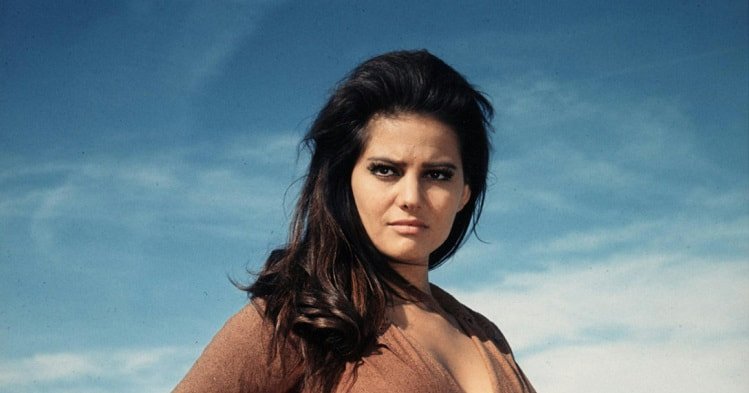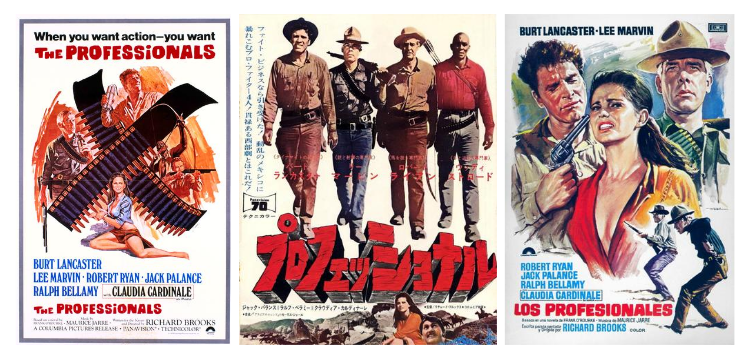|
In 1966, American film director Richard Brooks needed a hit. He had recently made Lord Jim, an epic adaptation of Joseph Conrad’s novel which had opened to poor reviews and a worse box-office return. His plan to get back on top surprised Hollywood insiders: he would adapt A Mule for the Marquesa, a recent Western novel by Frank O’Rourke. Released under the title The Professionals, Brooks’ new film would go on to become one of the most profitable Westerns of the 1960s, taking $9 million in the US alone.
Today, The Professionals is often overshadowed by other classic American Westerns of the 1960s, not to mention the best of the Italian Westerns that came to prominence at that time. It is sometimes described as a merely “crowd-pleasing”, or “undemanding” film - one that delivers excitement but asks little of its audience. In fact, The Professionals is more than just box-office dynamite - it’s a gripping but also thoughtful movie, with a terrific script that reflects Brooks’ ideas about life, death, loyalty, and revolution. It’s this combination of action, humour, solid craft, and big ideas that make the movie an unmissable Western.
The film’s title helps set it within the then-emerging tradition of the revisionist Western. The main characters in the movie are professionals - mercenaries motivated primarily by money, and a far cry from the honour-bound cowboys of the traditional Western. Significantly, the film is set in a relatively late time period, in 1917. Slowly, the revolver and the horse are giving way to the machine-gun and the automobile as the Old West fades into legend. However, the characters are very much of this time - they are not heroic anachronisms like Kirk Douglas’ character in Lonely are the Brave (1962), who represented lost frontier values in the face of soulless modernity.
The movie opens with Texas oil baron J.W. Grant (Ralph Bellamy) and his effort to recruit a team of men for a special and dangerous task - the rescue of Grant’s kidnapped wife, who has been taken across the border to Mexico. The culprit is Jesus Raza (Jack Palance), a veteran revolutionary whom Grant calls “the bloodiest cut-throat in Mexico”. Reflecting the moral ambiguity of the film, two of the men Grant recruits are not only familiar with Raza - they have fought alongside him in the past. Lee Marvin plays Henry “Rico” Fardan, a taciturn expert in weapons and tactics while Burt Lancaster stars as Bill Dolworth, a master of explosives with a lust for life and a thirst for destruction. The team is rounded out by the compassionate horse wrangler Hans Ehrengard (Robert Ryan) and the dependable archer and tracker Jake Sharp (Woody Strode). Together, they are to locate Raza’s desert fortress, mount a lightning strike to rescue Maria Grant, and return with her to the United States. What appears to be a simple enough task inevitably descends into a life-or-death struggle for the mercenaries - and a chance for Brooks to deliver not only a wealth of exciting action, but also to have his characters confront questions about why they fight, and what is really worth fighting for.
Even leaving aside the film’s greater depths for a moment, The Professionals has more than enough happening on the surface to justify its status as a hit in 1966. Richard Brooks’ skill as director is all over the movie, and cinematographer Conrad L. Hall makes excellent use of the locations including Death Valley. Crucially, the cast is on top form throughout. Burt Lancaster and Lee Marvin in particular were at the peak of their powers, and built a believable relationship between their characters. Italian legend Claudia Cardinale plays the kidnapped Mrs. Grant, who makes a huge impression despite not appearing until after the hour mark. She is anything but the damsel in distress that the mercenaries are told to expect. “Certain women have a way of changing boys into men,” Rico observes, “and some men back into boys."
The opening of the film is full of the promise of adventure, as J.W. Grant’s personal train collects the mercenaries alongside the titles. Each of the main characters receives a brief introductory vignette offering an insight into their background, skills, and temperament. For example, Robert Ryan’s character Hans is shown punching a man who has violently mistreated a horse, reflecting his compassionate nature. This use of vignettes to rapidly introduce characters who later become a team has been used subsequently, notably in William Friedkin’s Sorcerer (1977). The film thoroughly delivers on that promise of adventure when the team begin their mission, with their respective skills contributing to some terrific action scenes, most notably the climactic raid on Raza’s desert fortress. The description of the film as “crowd-pleasing” is well deserved, and contributed to by a rousing - if slightly repetitive - score by French composer Maurice Jarre.
As brilliantly staged as they are, there is a great deal more going on in The Professionals than just gunfights and explosions. Burt Lancaster’s biographer Kate Buford described the film as “many-layered”, and film critic Derek Malcolm called it “a much more literate Western than most.” The most important thread that runs through the film is the conflict between self-interest and dedication to a cause. Rico reassures Dolworth that their return to Mexico is “strictly for cash”, but after Maria is rescued she points out that to have fought in Mexico for so long with little payment, the mercenaries must have been true believers in the cause - at least for a time. While he tries hard to appear aloof and self-interested, Dolworth has to admit his romanticism as the story progresses - finally admitting to Rico, “this will come as a shock to both of us. I’m a born sucker for love.”
The character of Raza is also caught within this conflict between greed and romanticism. He is initially made out to be a savage murderer, who has captured Maria Grant only to secure a $100,000 ransom. The mercenaries find this hard to believe, having developed a high respect for him during the fighting in Mexico years earlier. Gradually, they realise that Raza remains more of a true revolutionary than a bandit, even as he grapples with the meaning of revolution. This culminates in one of the film’s most memorable scenes, a bittersweet talk about revolution between Raza and Dolworth as both lie injured in a desert pass. By this point, it’s clear that one of the greatest strengths that The Professionals has is its fantastic script, which was also written by director Richard Brooks. The movie is full of crackling dialogue, particularly between Lee Marvin and Burt Lancaster. It is dialogue that ties the film together, unifying its joint ambitions to both entertain and address larger questions. The Professionals is surely one of the most quotable Westerns of all time, but each brilliant exchange not only raises a smile but also exposes the psychology of the characters, and their own particular view of a changing world. A simple but very effective technique Brooks uses is a one-two punch of great lines, with the first perfectly setting up the second. Near the start of the film, J.W. Grant points at an old photograph and says to Rico, “your hair was darker then.” This sets up Rico’s memorably wry response, “my heart was lighter then.” Exchanges like this, delivered by a great cast, are a window into deep and enduring characters. The Professionals is so exceptionally exciting and well-made that its surface appeal would keep audiences coming back time and again - and has done, ever since 1966. That Frank O’Rourke, Richard Brooks and his cast went deeper than this means that the film has something new to offer on every viewing. It’s more than box-office dynamite - it’s an all-time classic Western.
0 Comments
Your comment will be posted after it is approved.
Leave a Reply. |
About
Exploring classic science fiction, with a focus on the 1950s to the 1990s. Also contributing to Entertainium, where I regularly review new games. Categories
All
|


